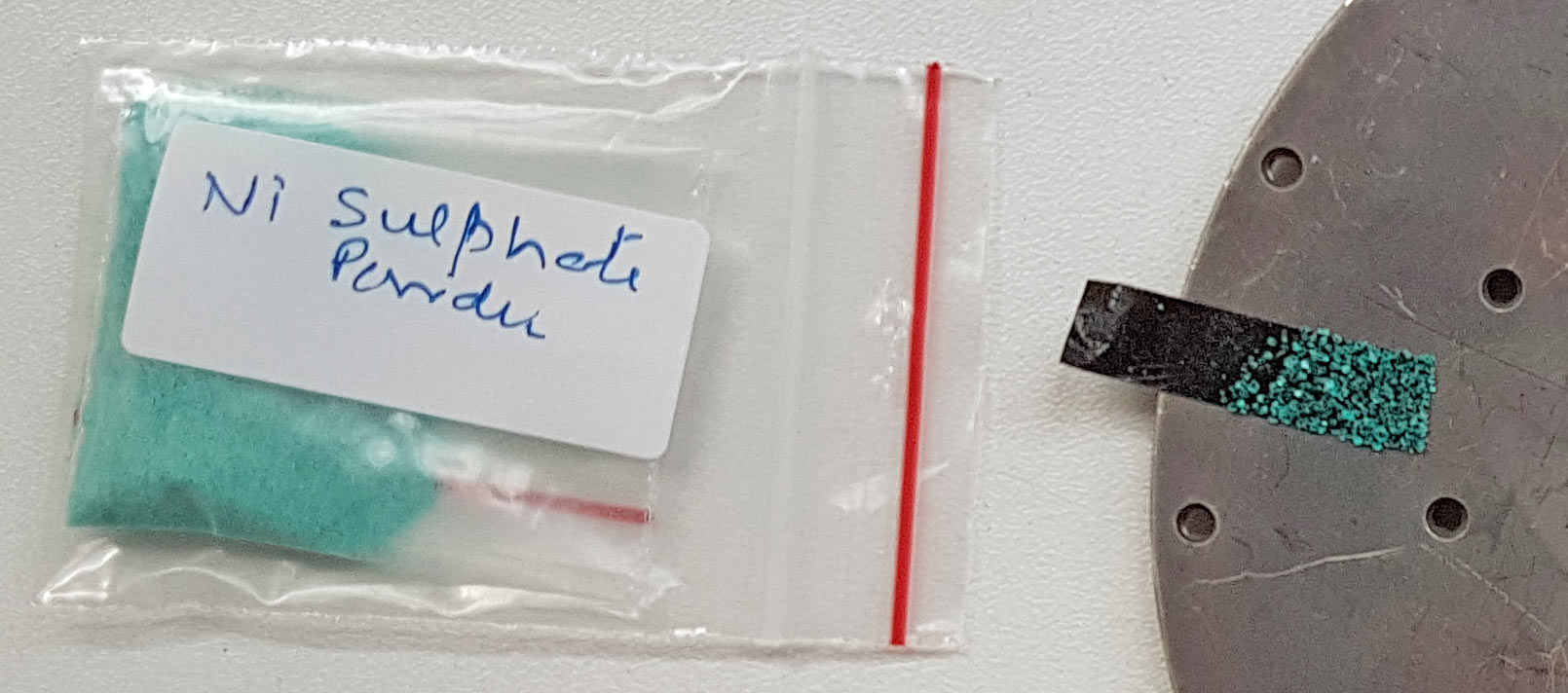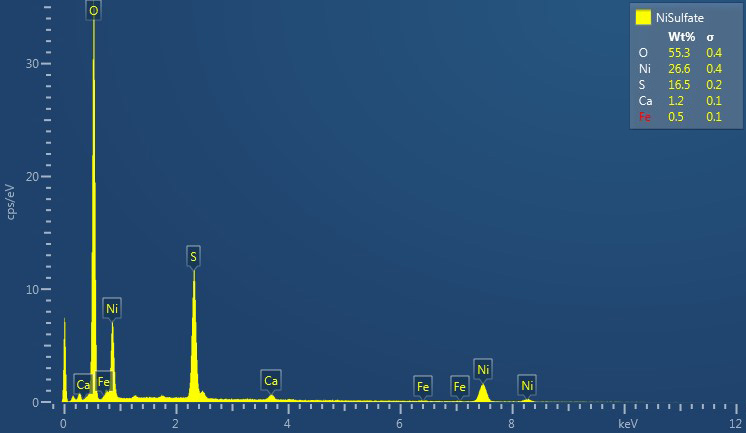ECCO - Samples arrived, Nickel Sulphate used has been tested
So, did it have Gold, Silver and Palladium in it??
Kudos first to the Indian postal system, it took just 7 days from Mumbai, India to Brno, Czech Republic. Thanks also to Suhas and his team for putting this together at our request.
For those that are unfamiliar with Suhas Ralkar's process for creating Nickel foil - please check out our previous article here. Nickel Sulphate is mixed with de-ionised water, the combination of which is used to electro-deposit Nickel foil onto 304 Stainless Steel by way 300khz of 200V DC ultrasonic 'hydrogen plasma' and in sympathy vibrations.
So, first sample to be tested was Nickel Sulphate, which was placed on a piece of carbon tape, that was then attached to the SEM table.

Under the microscope

Since this is to be dissolved into the plating solution, the size is not really that important, however, the elements are of much interest. So what did we see?
Elemental composition

What was observed was pretty much expected, near pure Nickel Sulphate, with a little Calcium. The iron indicated was not outside the error margin for detection, besides, there is much more iron in the steel electrodes.
Calcium is a quite common contamination in Nickel plating solutions, however, if de-ionised water is used and it is kept below 500ppm it will not create any aesthetically displeasing fine roughness, though for LENR, this actually may be desirable. See commentary here.
Calcium contamination can cause problems at concentrations of about 500 ppm. Typically the problem will be a fine roughness, which is often mistaken for pitting. If calcium contamination is causing the problem, its presence can be confirmed by shining a light through the hot (160°F) plating solution and looking for fine, needle-shaped crystals. Although the roughness could disappear when cooled, experience dictates that a removal treatment is needed. The preferred method is to precipitate calcium as the fluoride salt by the addition of 1.0–1.5 g/L of sodium bifluoride, followed by high-pH treatment and filtration. Calcium is not completely removed but is reduced to a more desirable level (100–200 ppm). Calcium problems are best avoided by using deionized water make up.
Source
Conclusion
What we can say is, there is no Holmium, Tantalum or Gold, neither was there any Silver, Copper or Palladium in the Nickel Sulphate. So, where did it come all from?
I have a problem. The Suhas ECCO Reactor discharge types belongs to low pressure glow discharge or high-pressure glow discharge?
Is the hydrogen pressure inside the reactor less than 133pa or atmospheric pressure 1bar?
The Nickel Sulphate is used to produce Nickel foil in a process described in this article, which is essentially at atmospheric pressure. This nickel foil is then scrunched into balls and one flattened, these are placed at either end of the fuel load in the reactor cores, you can see diagram in this article. Several reactor cores are placed into an array in a sealed chamber the is then evacuated, which you can also see a schematic of in the previously supplied link also. It is our understanding that the TiH2 that is added in to the fuel after processing, is then released into the cores and bleeds out via the 'breathable' Nickel foil plugs into the wider core holding cavity.
It is not known what the pressure is in the main reactor, we know that the distance between the electrodes is 22mm, at the cathode, there is the tip of a thoriated tungsten welding rod penetrating the foil and forming a discharge initiator. Suhas has specifically said in our sound cloud recordings, that the voltage is set so that there is NOT a spark, but a glow discharge - indeed, he says that if there is a spark discharge the core will explode. One might be able to estimate the H2 pressure therefore in the 5mm ID tube, from the 22mm electrode separation and the fact that the 1Mhz DC pulses are applied in the range 2000 - 2400V - presumably, the voltage varies with pressure in some sort of feedback such that no spark is caused. The complication with calculating this is that it is not a simple gas in a tube situation as the fuel is fluidised in it by the attached ultrasonic horn.
We will see if there is a way of getting a precise metric on the H2 either. When asked, he just has a basic vacuum pump and no pressure gauge, perhaps, if we can determine the plumbing, when can put a absolute pressure gauge in the system when we are there after the main testing. This is a good point to have raised, thank you.
The article said the addition of 10% TiH2 fuel as a hydrogen source , TiH2 500C above all will slowly decompose, the total fuel quality of 1.6g, so the quality of TiH2 0.16g, all the decomposition to produce hydrogen about 70cm3 (atmosphericpressure volume), from the reactor size inside the reactor volume is relatively small, I want to pressure reactor should be relatively high.
In addition, ordinary DC discharges can only glow at very low atmospheric pressure, but pulsed high voltage direct current discharges glow at relatively high pressures.
Thank you for your hard work!
Thankyou for your analysis. Things to hold in mind.
Another question is, does the reactor need no resistance wire to warm up? Thank you
A heater resistance wire is not needed. It is claimed to get up to temperature in 5 minutes. There is 100W per core on the discharges, 800W in total and 15-35W in 1MHz ultrasonics per core.
What time you will go to India test ECCO reactor?I wish you everything goes well, thank you
As things stand now, as soon as Dr. George Egely is ready, which may be in second week July.
nice stat..u definitely did some research on it..Thank dear
Thanks, we want to find out how Suhas is making those precious metals!